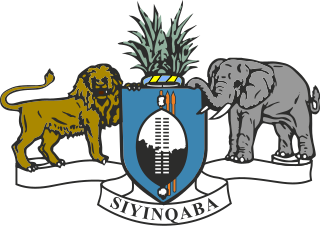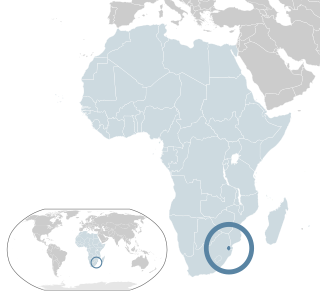Related Research Articles

Eswatini, officially the Kingdom of Eswatini and also known by its former official name Swaziland and formerly the Kingdom of Swaziland, is a landlocked country in Southern Africa. It is bordered by Mozambique to its northeast and South Africa to its north, west, south, and southeast. At no more than 200 km (120 mi) north to south and 130 km (81 mi) east to west, Eswatini is one of the smallest countries in Africa; despite this, its climate and topography are diverse, ranging from a cool and mountainous highveld to a hot and dry lowveld.

Eswatini, is a country in Southern Africa lying between Mozambique and South Africa. The country is located at the geographic coordinates 26°30′S31°30′E. Eswatini has an area of 17,363 square kilometres, of which 160 are water. The major regions of the country are Lowveld, Midveld and Highveld.
The economy of Eswatini is fairly diversified. Agriculture, forestry and mining account for about 13 percent of Eswatini's GDP whereas manufacturing represent 37 percent of GDP. Services – with government services in the lead – constitute the other 50 percent of GDP.

Mbabane is a city in Eswatini, and is one of the two capitals, serving as the executive capital.

Mswati III is Ngwenyama (King) of Eswatini and head of the Swazi royal family. He heads Africa’s last absolute monarchy, as he has veto power over all branches of government and is constitutionally immune from prosecution.

Hhohho is a region of Eswatini, located in the north western part of the country. Hhohho was named after the capital of King Mswati II, who expanded the Swazi territory to the north and west, taking in the districts of Barberton, Nelspruit, Carolina and Piet Retief. These areas were later acquired by what was the Province of Transvaal and today they form part of the Mpumalanga Province of South Africa. It has an area of 3,625.17 km², a population of 320,651 (2017), and is divided into 14 tinkhundla. The administrative center is the national capital of Mbabane. It borders Lubombo Region on the southeast and Manzini Region in the southwest.

Manzini is a region of Eswatini, located in the center-west of the country. It has an area of 4,093.59 km2 and a population of 355,945 (2017). Its administrative center is Manzini. It borders all three other regions of Eswatini: Hhohho in the north, Lubombo in the east, and Shiselweni in the south. It is bordered by the Mpumalanga province in South Africa to the west.

Lobamba is a city in Eswatini, and is one of the two capitals, serving as the legislative, traditional, spiritual, seat of government of the Parliament of Eswatini, and Ludzidzini Royal Village, the residence of Queen Ntfombi, the Queen Mother.
Child labour in Eswatini is a controversial issue that affects a large portion of the country's population. Child labour is often seen as a human rights concern because it is "work that deprives children of their childhood, their potential and their dignity, and that is harmful to physical and mental development," as defined by the International Labour Organization (ILO). Additionally, child labour is harmful in that it restricts a child's ability to attend school or receive an education. The ILO recognizes that not all forms of children working are harmful, but this article will focus on the type of child labour that is generally accepted as harmful to the child involved.

The University of Eswatini is the national university of Eswatini.

iNgwenyama is the title of the male monarch of Eswatini. In English, the title is sometimes translated as King of Eswatini. The iNgwenyama reigns together with the Ndlovukazi, a spiritual leadership position held by the iNgwenyama's mother or another female royal of high status.
Education in Eswatini includes pre-school, primary, secondary and high schools, for general education and training (GET), and universities and colleges at tertiary level.

Malolotja National Park covers 18,000 hectares of mountain wilderness on Eswatini's northwestern border with South Africa. The park includes Ngwenya Mountain, Eswatini's second highest mountain, and Malolotja Falls which drop 89 metres (292 ft), the highest in Eswatini. Habitats include short grassland to thick riverine scrub, bushveld and Afromontane forest.
The University of Botswana and Swaziland was the predecessor of both the University of Botswana and the University of Eswatini. It existed from October 20, 1975 when the Lesotho campus of the University of Botswana, Lesotho and Swaziland (UBLS) withdrew to form the National University of Lesotho (NUL), until June 1982 when the two universities in Botswana and Eswatini were established. The campuses of this university were in Kwaluseni and Luyengo in Eswatini and Gaborone in Botswana. Part I studies of bachelor's degree studies were undertaken in Eswatini and part II was done in Gaborone. However, law studies were done in Eswatini.
Ayanda Dube; is a Swazi model and beauty pageant titleholder who was crowned Miss Swaziland 2011 and represented her country in the 2012 Miss Universe pageants.
The University of Botswana, Lesotho and Swaziland (UBLS) was a predecessor to the universities of the respective countries, presently the National University of Lesotho, the University of Botswana, and the University of Eswatini. The University was originally known as the University of Basutoland, Bechuanaland and Swaziland (UBBS), which had its headquarters in Lesotho between 1964 and 1975. The UBBS had developed from the Pius XII Catholic University College at Roma, which was the product of a long-held desire of the Roman Catholic hierarchy in Southern Africa for an institution of higher learning for Africans.
Matata is a town in Eswatini.

The history of the Jews of Eswatini, formerly Swaziland.
A series of protests in Eswatini against the absolute monarchy and for democratisation began in late June 2021. Starting as a peaceful protest on 20 June, they escalated after 25 June into violence and looting over the weekend when the government took a hardline stance against the demonstrations and prohibited the delivery of petitions. Lower-level unrest and protests continued until summer 2023.
References
- ↑ Dlamini, Betty Sibongile. "Bhunu (1876?–1899)". The Dictionary of African Biography. Oxford, England: Oxford University Press. doi:10.1093/acref/9780195301731.013.48417.
- ↑ Fitzpatrick, M. South Africa, Lesotho and Swaziland. Lonely Planet.